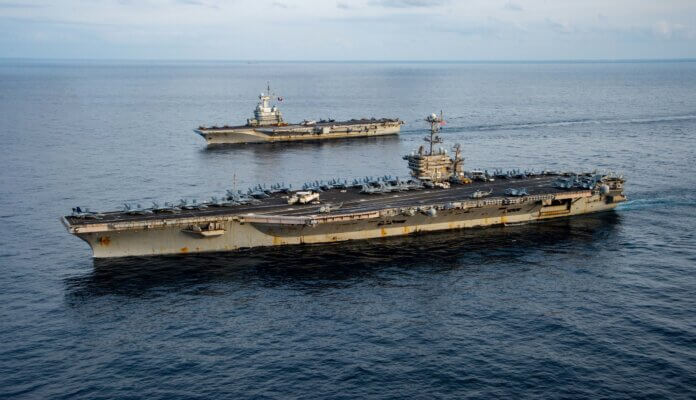
NATO is enhancing its immediate and longer-term maritime presence to build deterrence now and into the future, a senior alliance official told a recent conference in London.
As part of its broader strategic response to growing Euro-Atlantic instability since 2014, and particularly since the onset of conflict in Ukraine, NATO member states – individually and collectively – have increased naval presence.
“NATO’s maritime forces are focused on projecting a credible deterrent posture, actively working to avoid miscalculation or inadvertent escalation, but also making sure the alliance’s resolve to respond when threatened should not be doubted,” Admiral Rob Bauer, a Royal Netherlands Navy officer and current Chair of the NATO Military Committee, told the Royal United Services Institute (RUSI) seapower conference on 5 April.
This current NATO naval presence has included five aircraft carriers on operational deployment across the Euro-Atlantic theatre, including: the US Navy’s USS Harry S Truman and the French Navy’s FS Charles de Gaulle and their carrier strike groups (CSGs), and the Italian Navy’s ITS Cavour, operating in the Mediterranean; the UK Royal Navy’s (RN’s) HMS Queen Elizabeth in the North Atlantic; and the RN’s HMS Prince of Wales and its Carrier Strike Group (CSG) in the Arctic, for NATO’s Exercise Cold Response.
As regards alliance commitment to collective deterrence and defence, “A good example of this are the recent deployments of CSGs across the span of the Mediterranean and off the coast of Norway – not geographically threatening, but a very powerful display of capability,” said Adm. Bauer.
These CSGs are amongst more than 150 allied ships at sea, Adm. Bauer noted. As part of this mass, he continued, “Crucially, we have fully manned NATO’s standing naval forces [SNFs].” The presence of such SNFs is crucial, he explained: “Together with cyber and space, the maritime is the only domain where NATO and Russian forces actually meet, in the global commons.”
Such SNF presence is central to NATO’s ‘Deterrence and Defence of the Euro-Atlantic Area’ (DDA) concept. In response to the conflict in Ukraine and under the DDA, “For the first time in the alliance’s history, we activated all five graduated response plans and deployed elements of the NATO Response Force like the Very High Readiness Joint Task Force, in the context of collective defence,” said Adm. Bauer.
Within this response, the SNFs are now operating as High-Readiness Maritime Task Forces under NATO command and control.
Adm. Bauer also underlined the importance of continuing investment in future capabilities and concepts.
Alongside member state investment in submarines, frigates, anti-submarine warfare (ASW) helicopters, maritime patrol aircraft, and unmanned systems, NATO collectively is looking to improve maritime surveillance.
“NATO’s maritime community is developing a ‘Digital Ocean’ concept, which is designed to improve allies’ capacity to ‘see’ our oceans – through the creation of a global-scale network of sensors, from seabed to space – to better predict, identify, classify, and combat threats,” said Adm. Bauer.
“NATO is working to understand the potential of emerging and disruptive technologies in the maritime domain,” he continued. “With the Smart Defence Initiative project for ASW barriers, for instance, allies are exploring the use of unmanned systems, ‘big data’, and machine learning to develop agile, cost-effective methods for deterring and detecting submarines.”
by Dr. Lee Willett













